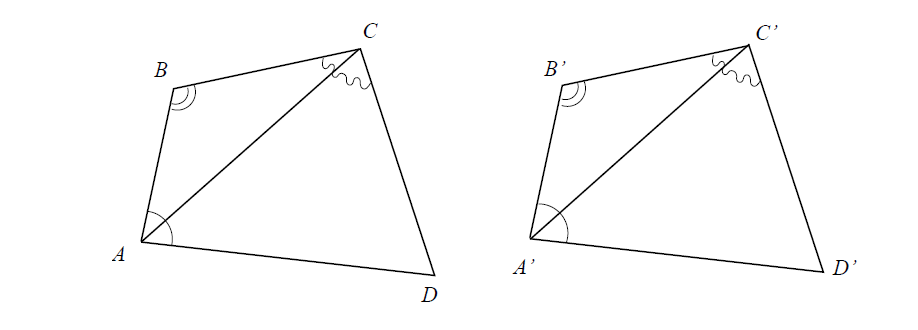Solution.
Theorem. If the vertices of two quadrilaterals are in one-to-one correspondence such that the three consecutive angles and two included sides of one quadrilateral are congruent to the corresponding angles and sides the other quadrilateral, then the quadrilaterals are congruent.
Proof.
Suppose quadrilaterals ABCD and A′B′C′D′ are such that ∠DAB≅∠D′A′B′,∠ABC≅∠A′B′C′,∠BCD≅∠B′C′D′,AB≅A′B′and BC≅B′C′. It must be shown that the quadrilateral ABCD is congruent to the quadrilateral A′B′C′D′. That it, by definition of congruence for quadrilaterals, it remains to establish that AD≅A′D′,CD≅C′D′ and ∠CDA≅∠C′D′A′.

Draw the segments AC and A′C′. Then by the SAS axiom △ABC≅△A′B′C′. Therefor AC≅A′C′,∠BAC≅∠B′A′C′ and ∠BCA≅∠B′C′A′. By the angle addition axiom m∠CAD=m∠BAD−m∠BAC and m∠C′A′D′=m∠B′A′D′−m∠B′A′C′. By assumption m∠BAD=m∠B′A′D′. It has been just concluded that m∠BAC=m∠B′A′C′. Therefor m∠CAD=m∠C′A′D′ and so m∠CAD≅m∠C′A′D′.
Similarly, the angle addition axiom implies that m∠ACD=m∠BCD−m∠BCA==m∠B′C′D′−m∠B′C′A′=m∠A′C′D′, and so ∠ACD≅∠A′C′D′. Therefor by the ASA Congruence Theorem for triangles △ACD≅△A′C′D′. This implies that AD≅A′D′,CD≅C′D′ and ∠CDA≅∠C′D′A′.
Thus the four sides and the four angles of ABCD are congruent to the corresponding sides and angles of A′B′C′D′ and hence the quadrilaterals ABCD and A′B′C′D′ are congruent as required.


Comments